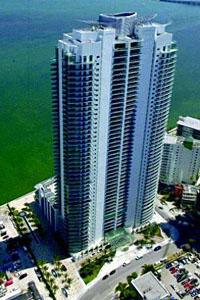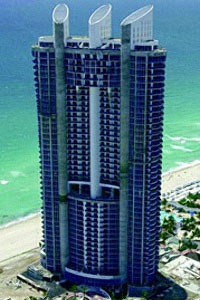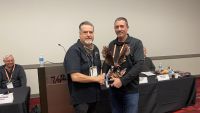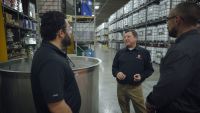Contractor to Contractor: Coastal Masonry, Inc.
By Masonry

Meet Randy Jensen, vice president of South Florida's Coastal Masonry and inventor of the Smart Masonry Clean-out System. Dedicated to his work in every respect, Jensen has helped grow Coastal Masonry Inc. to become a full-service industry leader. With more than 38 years in the business, Coastal has completed more than 1,000 projects, is a member of numerous trade associations, and remains active in apprenticeship programs. We sat down with Jensen to learn more about Coastal's active involvement in the industry, the keys to the company's success, and how Jensen's innovative tools have helped impact business.
Masonry: Tell us a little more about Coastal Masonry's history.
Jensen: Coastal Masonry was started in the late '60s by Gary Jones, and it's been in business since then. The company has done just about every type of masonry building, from housing developments to multi-family residences to churches, schools and government buildings. Now, we primarily concentrate on building high-rise hotels, apartments and condominiums. The company is still owned by Gary Jones, who is still very much involved in the business on a day-to-day basis.
Masonry: Your company is labeled as a "full service" masonry firm. Explain what services Coastal Masonry offers.
Jensen: In short, I would say that we bring a full scope of work to our contracts, meaning that all the work associated with masonry, including value engineering, grouting and professional layout, is included in all of our bids. It's important because we are then able to operate without relying entirely on other trades to do portions of the work necessary to go on and complete the masonry. A good example is that a lot of our competitors won't include or warrantee installation of rebar or grout in the block cells. We've found that by doing so, we maintain control over our own destiny because it's an integral part of staying on schedule with the work from one phase to another.
When I say we're full service, the operative word would probably be "full scope." Of course, that's another reason why most developers and general contractors do their best to get us aboard with them on major projects.
Masonry: Your website states that Coastal Masonry is known for its "fast track" approach to completing projects far ahead of schedule. Tell us what this approach entails.
Jensen: All projects today are fast track, meaning that the schedule is of utmost importance to the owner/developer, which includes all of the trades. To maintain the fast track schedule, your personnel must be trained to do their jobs and do them efficiently and timely. This way, not only your own crew of people can work smoothly and rapidly, but other trades can also follow behind and get their work done. Planning ahead is critical, which starts during the estimating process using custom designed software.
Masonry: Throughout your career, you have studied production enhancement methods, eventually creating the Smart Masonry Clean-out System. Explain how this product works and how it has boosted Coastal Masonry's efficiency.
Jensen: The Smart T-bolt and Window combination is used to withstand the pressures of grout during high-lift grouting within the vertical cells of block walls. High-lift grouting requires an inspection opening at the base of each vertical rebar. The transparent inspection windows are installed safely and with no tools prior to inspection. The process, as opposed to low-lift grouting, allows our block crews to build full height walls floor to floor without stopping to place rebar and grout at five-foot increments. Production increases dramatically by reducing 50 percent or more of the grouting operations and by eliminating unnecessary rebar laps that interfere with laying block. The increased production substantially adds to the bottom line.
The methods used prior to the invention of the Smart T-bolt and Window were a combination of bracing plywood, using cut nails or hard nails and hammering them through the plywood and into the face of the blocks to cover the inspection openings to withstand the grout pressures.
The problems associated with that were, first, when you cover something with a non-transparent material such as plywood, you can't see through it and you can't monitor the grout flow. What happens on nearly every job, at one time or another, is that your grout, while it's falling down through the vertical cells of the block, will have a hard clump of something within the mixture that will hang up, either on rebar, wire reinforcing or something within the cavity. It will then leave a hollow spot within that vertical cell. So, if you covered it up with plywood, you wouldn't realize that it's hollow until you pull the plywood off.
In the meantime, you've finished grouting and the grout that did come down the cell and perhaps stopped halfway down has already hardened. The only way to fix it is to break open the wall and pressure grout from the bottom upward. It's a very time-consuming and expensive process if, during the course of grouting, you have to come back and fix areas that were left ungrouted because you were not able to monitor the grout flow. Through the clear plastic windows, we can monitor the grout flow, fix any clogs during the grouting process, and know that all cells were filled completely.
Masonry: Coastal Masonry is actively involved in an apprenticeship program and has sponsored dozens of apprenticeships. How does this program benefit your business and the industry as a whole?
Jensen: As you might know, all across the country, and particularly in South Florida, we are desperately in need of qualified mechanics. I can't tell you how beneficial it is to have an apprenticeship program that produces mechanics for the future because of the lack of skilled workman that we have experienced in the last 10 years.

As far as our sponsorship is concerned, we and anyone else that have apprentices in an apprenticeship program of any kind understand that we're educating the apprentices for the industry as a whole; apprentices don't necessarily stay with one particular company. They may move from one area to another, or one job to another or simply out of state. We understand that this is a contribution to the industry as a whole, as well as a contribution to our own future of skilled workmen.
Masonry: Your company has successfully completed more than 1,000 projects, all with varied budgets and levels of detail. What has been your most difficult masonry project and how did you overcome the obstacles?
Jensen: We see projects designed with more difficulty as the years pass. In other words, most of the projects we do today, if I were to compare a similar project 10 years ago, we see far more emphasis on reinforced masonry than we did 10 years ago for similar-type projects. In addition, fast track design has an additional impact on new projects.
Also, less emphasis is put on modular design, that is, designing the structure to fit the masonry component. As a result, you find obstacles such as walls they design that aren't even accessible from the elevated floors of a high-rise. We often need to engineer a custom scaffold or outrigger system to even access these conditions. These are things we didn't see 10 years ago.
Nearly every one of our jobs has some or a lot of these obstacles that we need to overcome. It requires more out-of-the-box thinking and ingenuity today than it ever has.
Masonry: What do you feel is the biggest misconception about the masonry industry?
Jensen: I'll break this down into two parts. The first part is that when I was an apprentice in the late '60s, the biggest misconception then was that masons make too much money, but at the same time, the conception was that we were artisans at our trade. The basic misconception today is that masons make too much money because there's not enough artistry to their work and computer skills are not generally required.
Masonry: What would you do to change that misconception?
Jensen: I think that more masonry contractors and suppliers of masonry products need to participate in and provide more funding for training programs to train masons in the use of all types of materials — brick, stone, glass block — all types of masonry materials that are installed for artistic purposes, for architectural purposes. We see in South Florida a misconception that they can't design exposed architectural masonry because of two things: the high price and the lack of skilled labor to install it.
Everybody has a perspective. The supplier's perspective is that the masonry contractors should put forth more of an effort to train their people and then they can sell a wider variety of architectural products. Because the masonry industry consists of so many contractors that don't belong to any kind of association or apprenticeship program, it's nearly impossible for the few masonry contractors that do participate to fund the needed training alone.
I don't think suppliers put nearly enough money and/or effort in training or apprenticeship programs to train people to install their products. That's probably one of my biggest complaints in our industry; everyone's looking for somebody else to pay the bill and, even though Coastal Masonry probably puts in a larger effort than any other contractor that I know of in terms of training and support of these programs, we can't do it all by ourselves.
Masonry: What do you feel is the industry's biggest challenge in the near future? Do you think training is going to become a more serious problem?
Jensen: I think the training is already a serious problem. Not only training of skilled workmen is a serious problem, but training of masonry contractors is also a serious problem. We have too many unqualified masonry contractors bidding work they either don't understand or try to cut corners with sloppy workmanship.
Another problem that affects our workforce are the masonry contractors that pay cash to avoid payroll and insurance burdens, which put our industry employees at unnecessary risks and prevent them from obtaining car and home loans. If masons don't buy homes, their status in the community is reduced and young people choosing a career will not aspire to make masonry their chosen field.
These are the conditions here in Florida, California and Colorado — the three areas I've spent most of my working life. I can't speak for other areas of the country, but I suspect there's a little bit of that everywhere.

Masonry: Where do you think the masonry industry is going to be 10 years from now?
Jensen: I think the masonry industry is probably going to see a big turnaround because suppliers and masonry contractors are going to find themselves, at some point, needing to put much more money and emphasis on recruiting and training than they ever have in the past, just to keep up with the demand. As a result, I think we'll be in a better situation 10 years from now than we are today. I hope I'm right!
Masonry: What do you think will be the masonry industry's biggest competitor in 10 years?
Jensen: Tilt-up concrete. I moved here 10 years ago from California, where I contracted for a number of years. Through the 20-some years when I was in California, I saw the transition from block construction to tilt-up construction in all types of buildings. Ten years ago when I moved to Florida, it was still mostly block construction as opposed to tilt-up; now I'm seeing the transition take place here, just as it did in California. Where schools, office buildings, hospitals and warehouses used to be block five years ago, they're now mostly tilt-up concrete.
Masonry: What do you feel are the most critical issues you'll face with future government regulations?
Jensen: I think building codes should be examined and reexamined carefully each year by all parties, not to exclude masonry contractors. This goes back to what I mentioned before — designing buildings for strictly the design purpose as opposed to designing in a modular fashion to accommodate masonry.
I also think that engineers really need to have better education in the design of masonry, primarily in the design of reinforced masonry. What we see are designs that include drastic differences from one engineer to another in terms of the quantity and size of reinforcing necessary for their structure. That would leave anybody to conclude that they're not on the same page. I think that many of the buildings that are being designed today are being designed by people who are over-reinforcing masonry, making it much more costly and difficult than it needs to be. The bottom line is that I think design professionals need to have much more education than I'm seeing in the results of their work.
Masonry: Which group do you feel has a bigger impact on masonry's future: architects, engineers or general contractors?
Jensen: I believe it's certainly architects. They're the ones that we need to convince that masonry is a better, more economical, longer-lasting choice. They hold the key to our future of success. Architects that have chosen structures such as tilt-up are really the reason for the decline in our market.
Masonry: Is it the architects' fault?
Jensen: I wouldn't necessarily say so. There's been a lot more money spent on marketing tilt-up construction than there ever has been marketing masonry construction. I go back to the suppliers of masonry materials for that; they have not stepped up to the plate. You have to market to these architects or you're going to lose market share.
Masonry: What are your three biggest concerns in keeping your company successful?
Jensen: The first concern is to maintain a high degree of skilled workmen. Number two is to continue to be able to market our company's value because of the more complete scope that we bring to our projects than our competitors. And finally, we need to stay on the cutting edge by continuing to be innovative and proactive with our means and methods of construction.
Masonry: What do you like most about being a member of MCAA?
Jensen: The biggest benefit is the promotion of masonry in general. I can't say enough about its value. It provides returns on a noticeable daily basis. But overall, the promotion of masonry has provided a very good life for me and my family, and for a lot of my very close friends and co-workers as well.
About the Author
Masonry, the official publication of the Mason Contractors Association of America, covers every aspect of the mason contractor profession - equipment and techniques, building codes and standards, business planning, promoting your business, legal issues and more. Read or subscribe to Masonry magazine at www.masonrymagazine.com.


















